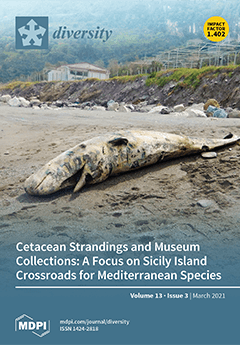Introduced species pose a threat to biodiversity, and ecological and physiological factors are important in determining whether an introduced species becomes successfully established in a new region. Locomotor performance is one such factor that can influence the abundance and distribution of an introduced
[...] Read more.
Introduced species pose a threat to biodiversity, and ecological and physiological factors are important in determining whether an introduced species becomes successfully established in a new region. Locomotor performance is one such factor that can influence the abundance and distribution of an introduced species. We investigated the effects of temperature and parasitism by the intestinal nematode
Aplectana hamatospicula on the maximum jump distance and endurance in one invasive and two native treefrogs in Florida, USA. We collected frogs from the wild, estimated their parasite loads, and tested their locomotor performance at three temperatures. Contrary to expectations, invasive Cuban treefrogs (
Osteopilus septentrionalis), which are adapted to a warmer climate in the Caribbean, outperformed pinewoods treefrogs (
Hyla femoralis) and squirrel treefrogs (
H. squirella) at each temperature, even when controlling for body size differences. In all three species, maximum jump distance was positively related to temperature, and this relationship was stronger for larger frogs. Parasites influenced both the maximum jump distance and endurance of frogs. In all three species, larger frogs jumped farther maximum distances than smaller frogs, but this relationship was stronger when frogs had lower, rather than higher, parasite loads. Parasitism had little effect on endurance in invasive frogs, but it tended to decrease the endurance of native frogs at high temperatures. Furthermore, at low temperatures, the lengths of consecutive jumps of infected native frogs tended to increase, suggesting that parasites limited the distances of initial jumps. Effects of temperature and parasites on the locomotor performance of frogs could influence their abilities to forage, escape predators, and disperse. The tremendous locomotor performance of
O. septentrionalis, which is maintained across temperatures and parasite loads, likely contributes to the invasion success of this species.
Full article





